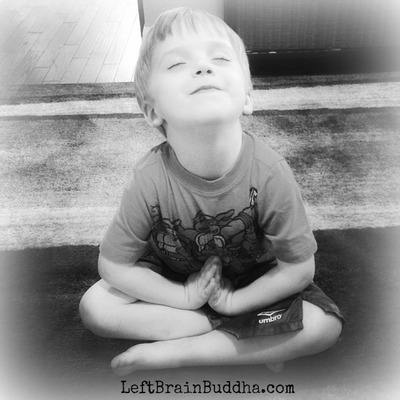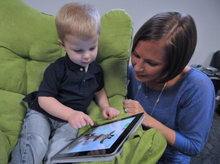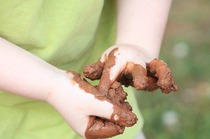Although research on mindfulness, especially with children and adolescents, is still in relatively early stages, an increasing number of studies have shown the potential benefits of mindfulness practices for students’ physical health, psychological well-being, social skills, academic performance, and more. Other studies have indicated that mindfulness may be effective for reducing stress and burnout in teachers and administrators as well.
The following list of selected articles, with brief descriptions of each study and its results, provides an overview of the current research on mindfulness in education.
Mindfulness and Students
Barnes, V. A., Bauza, L. B., & Treiber, F. A. (2003). Impact of stress reduction on negative school behavior in adolescents. Health and Quality of Life Outcomes, 1(10).
Forty-five African American adolescents (ages 15–18 years) were randomly assigned to either a Transcendental Meditation (TM) group (n = 25) or a health education control group (n = 20). The TM group engaged in 15-min meditation sessions at home and at school each day for 4 months. The control group was presented 15-min sessions of health education at school each day for 4 months. Findings demonstrated that the students who received the TM program showed reduced rates of absenteeism, rule infractions, and suspensions compared to the control group.
Barnes, V. A., Treiber, F. A., & Davis, H. (2001). Impact of transcendental meditation on cardiovascular function at rest and during acute stress in adolescents with high normal blood pressure. Journal of Psychosomatic Research, 51, 597–605.
This study examined the impact of the Transcendental Meditation (TM) program on cardiovascular reactivity in adolescents with high normal blood pressure. Thirty-five adolescents (34 African Americans) were randomly assigned to either TM (n = 17) or health education control (CTL, n = 18) groups. The TM group engaged in 15-min meditation twice each day for 2 months. The TM program appeared to have a beneficial impact upon cardiovascular functioning at rest and during acute laboratory stress in adolescents at-risk for hypertension, as the TM group exhibited greater decreases in resting blood pressure as well as other improvements compared to the control group.
Beauchemin, J., Hutchins, T. L., & Patterson, F. (2008). Mindfulness meditation may lessen anxiety, promote social skills, and improve academic performance among adolescents with learning disabilities. Complementary Health Practice Review, 13, 34–45.
Students with learning disabilities (LD; defined by compromised academic performance) often have higher levels of anxiety, school-related stress, and less optimal social skills compared with their typically developing peers. Previous health research indicates that meditation and relaxation training may be effective in reducing anxiety and promoting social skills. This pilot study used a pre–post no-control design to examine feasibility of, attitudes toward, and outcomes of a 5-week mindfulness meditation intervention administered to 34 adolescents diagnosed with LD. Post-intervention survey responses overwhelmingly expressed positive attitudes toward the program. All outcome measures showed significant improvement, with participants who completed the program demonstrating decreased state and trait anxiety, enhanced social skills, and improved academic performance.
Birdee, G. S., Yeh, G. Y., Wayne, P. M., Phillips, R. S., Davis, R. B., & Gardiner, P. (2009). Clinical applications of yoga for the pediatric population: A systematic review.Academic Pediatrics, 9, 212–220.
This review was conducted to evaluate the evidence for clinical applications of yoga among the pediatric population (0-21 years of age). Thirty-four controlled studies were identified published from 1979 to 2008. Clinical areas for which yoga has been studied include physical fitness, cardio-respiratory effects, motor skills/strength, mental health and psychological disorders, behavior and development, irritable bowel syndrome, and birth outcomes following prenatal yoga. No adverse events were reported in trials reviewed. While a large majority of studies were positive, results are preliminary based on low quantity and quality of trials. Further research of yoga for children utilizing a higher standard of methodology and reporting is warranted.
Biegel, G. M., Brown, K. W., Shapiro, S. L., & Schubert, C. M. (2009). Mindfulness-based stress reduction for the treatment of adolescent psychiatric outpatients: A randomized clinical trial. Journal of Consulting and Clinical Psychology, 77, 855–866.
The present randomized clinical trial was designed to assess the effect of the mindfulness-based stress reduction (MBSR) program for 102 adolescents age 14 to 18 years with different diagnoses in an outpatient psychiatric facility. Relative to treatment-as-usual control participants, those receiving MBSR self-reported reduced symptoms of anxiety, depression, and somatic distress, and increased self-esteem and sleep quality. Also, the MBSR group showed a higher percentage of diagnostic improvement over the 5-month study period and significant increases in global assessment of functioning scores relative to controls.
Broderick, P. C., & Metz, S. (2009). Learning to BREATHE: A pilot trial of a mindfulness curriculum for adolescents. Advances in School Mental Health Promotion, 2(1), 35-46.
This study reports the results of a pilot trial of Learning to BREATHE, a mindfulness curriculum for adolescents created for a classroom setting. The primary goal of the program is to support the development of emotion regulation skills through the practice of mindfulness. The total class of 120 seniors from a private girls’ school participated as part of their health curriculum. Relative to controls, participants reported decreased negative affect and increased feelings of calmness, relaxation, and self-acceptance. Improvements in emotion regulation and decreases in tiredness and aches and pains were significant in the treatment group at the conclusion of the program.
Carei, T. R., Fyfe-Johnson, A. L., Breuner, C. C., & Brown, M. A. (2010). Randomized controlled clinical trial of yoga in the treatment of eating disorders. Journal of Adolescent Health, 46, 346–351.
This was a pilot project designed to assess the effect of individualized yoga treatment on eating disorder outcomes among adolescents receiving outpatient care for diagnosed eating disorders. 50 girls and 4 boys, aged 11–21 years, were randomized to an 8 week trial of standard care versus individualized yoga plus standard care. The yoga group demonstrated greater decreases in eating disordered symptoms. Both groups maintained current BMI levels and decreased in anxiety and depression over time.
Davidson, R. J., Dunne, J., Eccles, J. S., Engle, A., Greenberg, M., Jennings, P., . . . Vago, D. (2012). Contemplative practices and mental training: Prospects for American education.Child Development Perspectives, 6(2), 146-153.
This article draws on research in neuroscience, cognitive science, developmental psychology, and education, as well as scholarship from contemplative traditions concerning the cultivation of positive development, to highlight a set of mental skills and socioemotional dispositions that are central to the aims of education in the 21st century. These include self-regulatory skills associated with emotion and attention, self-representations, and prosocial dispositions such as empathy and compassion. It should be possible to strengthen these positive qualities and dispositions through systematic contemplative practices, which induce plastic changes in brain function and structure, supporting prosocial behavior and academic success in young people.
Flook, L., Smalley, S. L., Kitil, M. J., Galla, B. M., Kaiser-Greenland, S., Locke, J., . . . Kasari, C. (2010). Effects of mindful awareness practices on executive functions in elementary school children. Journal of Applied School Psychology, 26(1), 70-95.
A school-based program of mindful awareness practices (MAPs) was evaluated in a randomized control study of 64 second- and third-grade children ages 7–9 years. The program was delivered for 30 minutes, twice per week, for 8 weeks. Children in the MAPs group who were less well regulated showed greater improvement in executive function (EF) compared with controls. Specifically, those children starting out with poor EF who went through the MAPs training showed gains in behavioral regulation, metacognition, and overall global executive control.

This study is a systematic review of the literature on the effect of yoga (as an exercise intervention for children) on quality of life and physical outcome measures in the pediatric population. The evidence shows physiological benefits of yoga for the pediatric population that may benefit children through the rehabilitation process, but larger clinical trials, including specific measures of quality of life, are necessary to provide definitive evidence.Galantino, M. L., Galbavy, R., & Quinn, L. (2008). Therapeutic effects of yoga for children: A systematic review of the literature. Pediatric Physical Therapy, 20, 66–80.
Greenberg, M. T., & Harris, A. R. (2012). Nurturing mindfulness in children and youth: Current state of research. Child Development Perspectives, 6(2), 161-166.
This article reviews the current state of research on contemplative practices with children and youth. It reviews contemplative practices used both in treatment settings and in prevention or health promotion contexts, including school-based programs. Interventions that nurture mindfulness in children and youth may be a feasible and effective method of building resilience in universal populations and in the treatment of disorders in clinical populations. This review suggests that meditation and yoga may be associated with beneficial outcomes for children and youth, but the generally limited quality of research tempers the allowable conclusions.
Gregoski, M. J., Barnes, V. A., Tingen, M. S., Harshfield, G. A., & Treiber, F. A. (2010). Breathing awareness meditation and LifeSkills Training Programs influence upon ambulatory blood pressure and sodium excretion among African American adolescents.Journal of Adolescent Health, 48, 59–64.
To evaluate the effects of breathing awareness meditation (BAM), Botvin LifeSkills Training (LST), and health education control (HEC), 166 African American adolescent participants with moderately high blood pressure (and thus an increased risk for development of cardiovascular disease) were randomized by school to either BAM (n = 53), LST (n = 69), or HEC (n = 44). In-school intervention sessions were administered for 3 months by health education teachers. The BAM treatment exhibited the greatest overall decreases in blood pressure and heart rate.
Harrison, L. J., Manocha, R., & Rubia, K. (2004). Sahaja yoga meditation as a family treatment programme for children with attention deficit-hyperactivity disorder. Clinical Child Psychology and Psychiatry, 9, 479–497.
This study investigated meditation as a family treatment method for children with ADHD, using the techniques of Sahaja Yoga Meditation (SYM). Parents and children participated in a 6-week program of twice-weekly clinic sessions and regular meditation at home. Results showed improvements in children’s ADHD behavior, self-esteem, and relationship quality. Children described benefits at home (better sleep patterns, less anxiety) and at school (more able to concentrate, less conflict). Parents reported feeling happier, less stressed and more able to manage their child’s behavior.
Jensen, P., & Kenny, D. (2004). The effects of yoga on the attention and behavior of boys with Attention-Deficit ⁄ Hyperactivity Disorder (ADHD). Journal of Attention Disorders, 7, 205–216.
Boys diagnosed with ADHD by specialist pediatricians and stabilized on medication were randomly assigned to a 20-session yoga group (n = 11) or a control group (cooperative activities; n = 8). Significant improvements from pre-test to post-test were found for the yoga, but not for the control group on five subscales of a parent rating scale, along with some other positive effects. Although these data do not provide strong support for the use of yoga for ADHD, partly because the study was under-powered, they do suggest that yoga may have merit as a complementary treatment for boys with ADHD already stabilized on medication, particularly for its evening effect when medication effects are absent.
Lawlor, M. S., Schonert-Reichl, K. A., Gadermann, A. M., & Zumbo, B. D. (2012). A Validation Study of the Mindful Attention Awareness Scale Adapted for Children.Mindfulness, 1-12.
A total of 286 fourth to seventh grade children completed the Mindful Attention Awareness Scale—Children (MAAS-C), a modified version of a measure designed to assess mindfulness in adults. Results indicated that mindfulness, as assessed via the MAAS-C, was related in expected directions to indicators of well-being across the domains of traits and attributes, emotional disturbance, emotional wellbeing, and eudaimonic well-being. These findings were in accord with those of previous research with the MAAS in adult populations.
Mendelson, T., Greenberg, M. T., Dariotis, J. K., Gould, L. F., Rhoades, B. L., & Leaf, P. J. (2010). Feasibility and preliminary outcomes of a school-based mindfulness intervention for urban youth. Journal of Abnormal Child Psychology, 38(7), 985-994.
Mindfulness-based approaches may improve adjustment among chronically stressed and disadvantaged youth by enhancing self-regulatory capacities. This paper reports findings from a pilot randomized controlled trial assessing the feasibility, acceptability, and preliminary outcomes of a school-based mindfulness and yoga intervention. Four urban public schools were randomized to an intervention or wait-list control condition (n = 97 fourth and fifth graders, 60.8% female). Findings suggest the intervention was attractive to students, teachers, and school administrators and that it had a positive impact on problematic responses to stress including rumination, intrusive thoughts, and emotional arousal.
Napoli, M., Krech, P. R., & Holley, L. C. (2005). Mindfulness training for elementary school students: The attention academy. Journal of Applied School Psychology, 21(1), 99-125.
This article presents results of a formative evaluation of whether participation in a mindfulness training program affected first, second, and third grade students’ outcomes on measures of attention. The training was designed and intended to help students learn to focus and pay attention. The 24-week training employed a series of exercises including breathwork, bodyscan, movement, and sensorimotor awareness activities. Results from three attentional measures administered to the students show significant differences between those who did and did not participate in mindfulness practice training.
Oberle, E., Schonert-Reichl, K. A., Lawlor, M. S., & Thomson, K. C. (2012). Mindfulness and inhibitory control in early adolescence. Journal of Early Adolescence, 32(4), 565-588.
99 fourth- and fifth-grade students completed a measure of mindful attention awareness (self-reported dispositional mindfulness) and a computerized executive function (EF) task assessing inhibitory control. Controlling for gender, grade, and cortisol levels, higher scores on the mindfulness attention awareness measure significantly predicted greater accuracy (% correct responses) on the inhibitory control task. This research identifies mindfulness—a skill that can be fostered and trained in intervention programs to promote health and well-being—as significantly related to inhibitory processes in early adolescence.
Razza, R. A., Bergen-Cico, D., & Raymond, K. (2013). Enhancing preschoolers’ self-regulation via mindful yoga. Journal of Child and Family Studies, 1062-1024.
This study evaluated the effectiveness of a mindfulness-based yoga intervention in promoting self-regulation among preschool children (3–5 years old). Twenty-nine children (16 intervention and 13 control) participated in the yearlong study. The mindful yoga intervention was implemented regularly by the classroom teacher for the treatment group. Results from direct assessments indicated significant effects of the intervention across three indices of self-regulation. There was also some evidence that the children who were most at risk of self-regulation dysfunction benefited the most from the intervention.
Schonert-Reichl, K. A., & Lawlor, M. S. (2010). The effects of a mindfulness-based education program on pre- and early adolescents’ well-being and social and emotional competence. Mindfulness, 1(3), 137-151.
This study evaluated the effectiveness of the Mindfulness Education (ME) program, which focuses on facilitating the development of social and emotional competence and positive emotions and has as its cornerstone daily lessons in which students engage in mindful attention training. Participants were 246 students in the 4th to 7th grades. Results revealed that students who participated in the ME program, compared to those who did not, showed significant increases in optimism from pretest to posttest. Similarly, improvements on dimensions of teacher-rated classroom social competent behaviors were found favoring ME program students. Program effects also were found for self-concept, although the ME program demonstrated more positive benefits for preadolescents than for early adolescents.
Semple, R. J., Lee, J., Rosa, D., & Miller, L. F. (2010). A randomized trial of mindfulness-based cognitive therapy for children: Promoting mindful attention to enhance social-emotional resiliency in children. Journal of Child and Family Studies, 19(2), 218-229.
Program development of mindfulness-based cognitive therapy for children (MBCT-C) is described along with results of the initial randomized controlled trial. Participants were boys and girls aged 9–13 (N = 25), mostly ethnic minorities from low-income, inner-city households. Participants who completed the program showed fewer attention problems than wait-listed controls and those improvements were maintained at three months following the intervention. A strong relationship was found between attention problems and behavior problems. Significant reductions in anxiety symptoms and behavior problems were found for those children who reported clinically elevated levels of anxiety at pretest.
Semple, R. J., Reid, E. F. G., & Miller, L. (2005). Treating anxiety with mindfulness: An open trial of mindfulness training for anxious children. Journal of Cognitive Psychotherapy, 19, 379–392.
This study is an open clinical trial that examined the feasibility and acceptability of a mindfulness training program for anxious children. Since impaired attention is a core symptom of anxiety, enhancing self-management of attention should effect reductions in anxiety. A 6-week trial was conducted with five anxious children aged 7 to 8 years old. The results of this study suggest that mindfulness can be taught to children and holds promise as an intervention for anxiety symptoms.
Tang, Y., Yang, L., Leve, L. D., & Harold, G. T. (2012). Improving executive function and its neurobiological mechanisms through a mindfulness-based intervention: Advances within the field of developmental neuroscience. Child Development Perspectives, 6(4), 361-366.
Mindfulness-based interventions that focus on increasing awareness of one’s thoughts, emotions, and actions have been shown to improve specific aspects of executive function (EF), including attention, cognitive control, and emotion regulation. This article reviews research relevant to one specific mindfulness-based intervention, integrative body-mind training (IBMT). Randomized controlled trials of IBMT indicate improvements in specific EF components, and uniquely highlight the role two brain-based mechanisms that underlie IBMT-related improvements. Short-term IBMT may improve specific dimensions of EF and thus prevent a cascade of risk behaviors for children and adolescents.
Thompson M., Gauntlett-Gilbert J. (2008). Mindfulness with children and adolescents: Effective clinical application. Clinical Child Psychology and Psychiatry, 13, 395-407.
This article aims to provide an overview of mindfulness to professionals who are working in child or adolescent settings. Initially, it provides some orientation to and definitions from the field, before summarizing the current evidence for the utility of the approach. The article recommends specific clinical modifications for mindfulness with children and adolescents, as well as reviewing how to monitor and enhance the development of this skill. Finally, it highlights important differences among mindfulness, relaxation and other meditative techniques.
Van der Oord, S., Bogels, S. M., & Peijnenburg, D. (2012). The effectiveness of mindfulness training for children with ADHD and mindful parenting for their parents.Journal of Child and Family Studies, 21(1), 139-147.
This study evaluated the effectiveness of an 8-week mindfulness training for children aged 8–12 with ADHD and parallel mindful parenting training for their parents. There was a significant reduction of parent-rated ADHD behavior of themselves and their child from pre-to posttest and from pre- to follow-up test. Further, there was a significant increase of mindful awareness from pre-to posttest and a significant reduction of parental stress and overreactivity from pre-to follow-up test. Teacher-ratings showed non-significant effects, however.
Zelazo, P. D., & Lyons, K. E. (2012). The potential benefits of mindfulness training in early childhood: A developmental social cognitive neuroscience perspective. Child Development Perspectives, 6(2), 154-160.
Early childhood is marked by substantial development in the self-regulatory skills supporting school readiness and socioemotional competence. Mindfulness training—using age-appropriate activities to exercise children’s reflection on their moment- to-moment experiences—may support the development of self-regulation by targeting top-down processes while lessening bottom-up influences (such as anxiety, stress, curiosity) to create conditions conducive to reflection, both during problem solving and in more playful, exploratory ways.
Zenner, C., Herrnleben-Kurz, S., & Walach, H. (2014). Mindfulness-based interventions in schools – A systematic review and meta-analysis. Frontiers in Psychology, 5, 603.
This article systematically reviews the evidence regarding the effects of school-based mindfulness interventions on psychological outcomes. Twenty-four studies were identified, of which 13 were published. In total, 1348 students were instructed in mindfulness, with 876 serving as controls, ranging from grade 1 to 12. All in all, mindfulness-based interventions in children and youths hold promise, particularly in relation to improving cognitive performance and resilience to stress. However, the field is nascent; there is great heterogeneity, many studies are underpowered, and measuring effects of mindfulness in this setting is challenging.
Mindfulness and Teachers
Flook, L., Goldberg, S. B., Pinger, L., Bonus, K., & Davidson, R. J. (2013). Mindfulness for teachers: A pilot study to assess effects on stress, burnout, and teaching efficacy. Mind, Brian, and Education, 7(3), 182-195.
This study reports results from a randomized controlled pilot trial of a modified Mindfulness-Based Stress Reduction course (mMBSR) adapted specifically for teachers. Results suggest that the course may be a promising intervention, with participants showing significant reductions in psychological symptoms and burnout, improvements in observer-rated classroom organization and performance on a computer task of affective attentional bias, and increases in self-compassion. In contrast, control group participants showed declines in cortisol functioning over time and increases in burnout. Changes in mindfulness were correlated in the expected direction with changes across several outcomes (psychological symptoms, burnout, and sustained attention) in the intervention group.
Jennings, P. A., Frank, J. L., Snowberg, K. E., Coccia, M. A., & Greenberg, M. T. (2013). Improving classroom learning environments by cultivating awareness and resilience in education (CARE): Results of a randomized controlled trial. School Psychology Quarterly. Advance online publication. doi: 10.1037/spq0000035
Cultivating Awareness and Resilience in Education (CARE for Teachers) is a mindfulness-based professional development program designed to reduce stress and improve teachers’ performance and classroom learning environments. A randomized controlled trial examined program efficacy and acceptability among a sample of 50 teachers randomly assigned to CARE or waitlist control condition. Participation in the CARE program resulted in significant improvements in teacher well- being, efficacy, burnout/time-related stress, and mindfulness compared with controls. Evaluation data showed that teachers viewed CARE as a feasible, acceptable, and effective method for reducing stress and improving performance.
Jennings, P. A., Snowberg, K. E., Coccia, M. A., & Greenberg, M. T. (2011). Improving classroom learning environments by Cultivating Awareness and Resilience in Education (CARE): Results of two pilot studies. Journal of Classroom Interactions, 46, 27-48.
Two pilot studies examined program feasibility and attractiveness and preliminary evidence of efficacy of the CARE professional development program. Study 1 involved educators from a high-poverty urban setting (n = 31). Study 2 involved student teachers and 10 of their mentors working in a suburban/semi-rural setting (n = 43) (treatment and control groups). While urban educators showed significant pre-post improvements in mindfulness and time urgency, the other sample did not, suggesting that CARE may be more efficacious in supporting teachers working in high-risk settings.
Roeser, R. W., Schonert-Reichl, K. A., Jha, A., Cullen, M., Wallace, L., Wilensky, R., Oberle, E., Thomson, K., Taylor, C., & Harrison, J. (2013, April 29). Mindfulness Training and Reductions in Teacher Stress and Burnout: Results From Two Randomized, Waitlist-Control Field Trials. Journal of Educational Psychology. Advance online publication. doi: 10.1037/a0032093
The effects of randomization to mindfulness training (MT) or to a waitlist-control condition on psychological and physiological indicators of teachers’ occupational stress and burnout were examined in 2 field trials. The sample included 113 elementary and secondary school teachers (89% female) from Canada and the United States. Teachers randomized to MT showed greater mindfulness, focused attention and working memory capacity, and occupational self-compassion, as well as lower levels of occupational stress and burnout at post-program and follow-up, than did those in the control condition. Group differences in mindfulness and self- compassion at post-program mediated reductions in stress and burnout as well as symptoms of anxiety and depression at follow-up.
Roeser, R.W., Skinner, E., Beers, J., & Jennings, P.A. (2012). Mindfulness training and teachers’ professional development: An emerging area of research and practice. Child Development Perspectives, 6, 167-173.
This article focuses on how mindfulness training (MT) programs for teachers, by cultivating mindfulness and its application to stress management and the social-emotional demands of teaching, represent emerging forms of teacher professional development (PD) aimed at improving teaching in public schools. MT is hypothesized to promote teachers’ “habits of mind,” and thereby their occupational health, well-being, and capacities to create and sustain both supportive relationships with students and classroom climates conducive to student engagement and learning. This article discusses emerging MT programs for teachers and a logic model outlining potential MT program effects in educational settings.
Singh, N. N., Lancioni, G. E., Winton, A. S., Karazsia, B. T., & Singh, J. (2013). Mindfulness training for teachers changes the behavior of their preschool students. Research in Human Development, 10(3), 211-233.
This study measured the effects of preschool teachers attending an 8-week mindfulness course on the behavior of the students in their classroom. Results showed that decreases in the students’ challenging behaviors and increases in their compliance with teacher requests began during mindfulness training for the teachers and continued to change following the training. While the students did not show a change in positive social interactions with peers, they did show a decrease in negative social interactions and an increase in isolate play. Results indicated that mindfulness training for teachers was effective in changing teacher-student interactions in desirable ways.
Mindfulness and Administrators
Wells, C. M. (2013). Principals Responding to Constant Pressure: Finding a Source of Stress Management. NASSP Bulletin, 0192636513504453.
This conceptual article presents a review of the research concerning the stress level of principals over the past three decades, with emphasis on the occupational stress that principals encounter because of heightened accountability and expectations for student achievement. Mindfulness meditation, as a stress management intervention, provides the theoretical background for this article; the scientific evidence concerning benefits of mindfulness meditations are reviewed. Finally, the author presents suggestions for the prevention and reduction of stress for principals








.jpeg)

